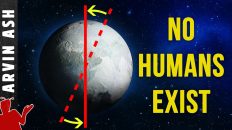Evidence for dark matter
Is dark matter real? What is dark matter made of?
When you look at the night sky what do you see? You see a few stars but you mostly see dark. What is in that dark – is it all a vacuum. What you may not realize is that night sky really would look like this…if you could see the hidden amount of matter that is invisible to our eyes.
One of the biggest if not the biggest question in science right now is: What is the universe made of?
Sure, I’ve talked about the standard model and quantum field theory in several videos which try to explain what the universe is made of. But these so far only attempt to explain what the visible matter in the universe is made of.
It turns out that visible matter, that’s everything that you can see on earth, and in space with our most powerful telescopes, is only a miniscule portion. There is about 6 time more matter in the universe than what we can see. This invisible matter is called dark matter. This means that what we are seeing are only the waves on top of the ocean. We are not seeing the ocean itself.
Yet without this ocean, we would likely not exist. So if this dark matter is invisible, how the heck do we know that it is even there? And if it exists then what could it actually be? You’ll be surprised how much we know about it. Let’s look at what our best theories in science have to say.
It turns out that we can detect invisible matter by its effect on the visible matter that we CAN see and detect. It has gravity. In fact the gravitational effect of this dark matter is so profound, that none of us would likely exist without it. The Milky way galaxy as we know it would not exist, and probably neither would life. But what do we know about dark matter, and what do our best theories say about what it could actually be?
The first evidence of Dark Matter came from Swiss astronomer Fritz Zwicky in the 1930’s, when he saw that the galaxies in clusters like the Coma cluster were moving at very high speed. In fact they were moving so fast that the galaxies could not stay gravitationally bound and should get ripped apart unless they had 100 time the matter that he could see visibly.
He coined the term “Dark Matter” to describe this invisible mass. The problem was nobody believed him. He was kind of an eccentric and not very likeably guy. He described people he didn’t like as spherical bastards because they were bastards no matter which way you looked at them. Most scientists either ignored him or didn’t believe him.
It wasn’t until almost 40 years later, in the 1970’s, that observations by Vera Rubin confirmed the idea of dark matter. She measured that the velocity of stars on the outer edge of galaxies was about the same as those closer to the center. But the mass at the edge of galaxies based on visible stars gets smaller. This appeared to be impossible to explain without the concept of unseen matter causing gravitational effects on the outer edges of galaxies.
If you compare the orbital speed of planets around the sun, you find that the speed slows down the further away from the sun you go. The curve of speed vs distance from the sun follows a one over the square root of distance relationship. However, when you look at the orbital speed of the stars in the milky way galaxy, you find that almost all stars are orbiting at the same speed, about 200 km/s.
Near the center of the galaxy, there is enough visible matter to account for this speed, but as you get further out, there is a greater and greater mismatch between the orbital speed of the stars and the visible matter. This is the reason it is thought that most of the dark matter forms a kind of halo around the galaxy. There is likely less of it near the center of the galaxy, but a lot more the further out you go.
How do we know that this dark matter is not just ordinary matter that is hard to see, like dim stars or black holes? This was thought to be a possibility decades ago, and some of these were categorized as MACHOS – massive compact halo objects. But today we have so much observational data, that this possibility has been all but ruled out. The distribution of dark matter based on the rotational curves gives us a clue. It appears to be distributed evenly as well as like a halo around the outer edge of galaxies, and not clumped up like visible matter is. This can be explained if we theorize that this matter interacts very weakly with itself.
But ordinary matter does not interact weakly, and thus tends to clump together. Ordinary matter would likely not be so evenly distributed.
Research as recent as 2019 from a team in Japan appears to have ruled out primordial black holes as being the source of dark matter. In addition, there are other more technical reasons as well, having to do with the rate at which new elements were formed in the early universe, which indicate that only about 5% of the energy density of the universe can be explained by ordinary matter. The rest has to be dark matter and dark energy. I’ll be getting into the details dark energy in a future video.
BTW, most of the ordinary matter in galaxies is not in the form of stars and planets, but interstellar gases. If you added up all the mass of this gas, it would be about 3 times as much mass as all of the stars and planets of the galaxy put together. So a pie chart of the mass of galaxies, looks like this: 4 percent stars and planets, 11 percent gas, and 85 percent is dark matter.
The bullet cluster is, I think, the most interesting evidence showing how the behavior of Dark matter is not like ordinary matter. This is an enhanced photograph of two clusters of galaxies passing through each other. In a computer simulation of this, what you can clearly see is that gases of the two galaxies are interacting with each other and heating up to emit X-rays, which are visible as bright pink areas. This is the ordinary matter of the two clusters.
The majority of the matter however, as indicated by gravitational lensing, is in the blue areas of the photo. This is the dark matter that simply did not interact with the ordinary matter or with itself, as the two clusters collided, and just passed right through. So you can clearly see that most of the mass is not where most of the ordinary matter is in this cluster.
There are some physicists who have argued that dark matter does not exist, and that the rotation curves can be explained if the laws of gravity were in fact different at larger distances. Again, this behavior in the bullet cluster would be hard to explain if that was the case.
Inventing a new particle is probably less crazy than proving the laws of gravity wrong, given the mountains of evidence that prove Einstein’s general relativity correct.
So if it is not dim ordinary matter, and not due to changes in gravity, then what the heck is it.
Let’s look at what properties a potential dark matter particle would need to have.
1) First, obviously it must be dark. This means It does not emit any light and doesn’t interact with anything to emit light or any kind of electromagnetic radiation,
2) It must of course interact through gravity, so it can not be a zero rest mass particle like photons.
3) It must not interact with itself, or interact very weakly.
4) It must be cold. That is it is not moving at very high speeds, because if it was, then after the big bang, it would have just kept on going and not slowed down to form halos around ordinary matter.
5) It must be stable, this is, it does not decay, because If it decayed into other particles, it wouldn’t still be here now in such large quantities, 13.8 billion years after the big bang.
If it’s a particle, could it be hiding in plain sight, in the standard model of particle physics? We need a particle that does not decay and is neutral. The only massive neutral particle in the standard model that is stable is the neutrino. But because neutrinos are so light, they are not cold. They move very fast, so they are like hot dark matter. This would preclude neutrinos from making the large structures in the universe because the neutrinos would want to move away, while the ordinary matter wants to come together, so the net effect would have been a smoothing out of the ordinary matter.
If we invent a new particle that does not interact with electromagnetism, has no strong nuclear force interactions, but does interact through the weak nuclear force and through gravity, then we have just invented the dark matter particle. Scientist have a name for this particle – it’s WIMP or weakly interacting massive particle.
Why would this particle need to interact through the weak nuclear force? Because it turns out that If we ask the question – What is the rate of interaction of dark matter particle and antiparticle annihilation that you would need to give us the correct ratio of dark matter that we observe today? The answer is they would need to interact with the strength exactly equal to the strength of the weak nuclear force. This coincidence is called the WIMP miracle.
And It so happens that there is a model in particle physics that predicts exactly such a particle. This model is called supersymmetry. Scientists like the WIMP because it was not invented for the purposed of solving the dark matter problem, but comes about naturally in string theory. And String theory requires supersymmetry to work.
So what is supersymmetry?
Supersymmetry is a special kind of symmetry between force particles (the bosons) and matter particles (the fermions) that take up space.
Supersymmetry says for every kind of fermion particle, there would be corresponding boson particle with the same charge and mass, and it would have the same strong and weak nuclear force interactions. It would just have a different spin.
Supersymmetry has not been found to confirmed in nature, but If supersymmetry is true, then the dark matter mystery could be solved, because there would be a perfect candidate for a dark matter particle in supersymmetry. And it is called the neutralino. The neutralino would be the lightest supersymmetric partner of the photon, the Z boson, and the Higgs bosons.
So supersymmetry would double the particles in the current standard model. Is this complication worth it? Well, dark matter is a benefit, but the fact that it makes string theory work is also a benefit, and it explains some mysteries as well such as why the Higgs boson is lighter than it should be.
But the biggest problem with the Neutralino theory is that we should have been able to detect it at the Large Hadron Collider, and so far we have not. So this puts a big damper on this theory.
The axion is the second viable candidate to be the dark matter particle. The axion was invented to solve a problem having to do with charge conjugation and parity symmetry problem with the strong nuclear interaction. This is also called the strong CP problem.
CP symmetry basically means that the laws of physics should be the same if a particle is replaced by its antiparticle (C symmetry) and its spatial coordinates are inverted to its mirror image (P symmetry). This is a technically complicated issue for the strong nuclear force, but we can simplify it by calling it the electric spin problem of neutrons. It so happens that the theorized existence of a particle called the axion solves this problem in physics.
Essentially, the problem can be more simply shown in the following way. As you know, protons and neutrons make up the nucleus of atoms. The neutron has a property called a magnetic moment or spin. This means that if you put the neutron in a magnetic field, the neutron will have a spin. The reason for this spin, even though it has no charge is because the neutron is made up of three quarks, all of which combine to give the neutron a spin. This is confirmed by observation.
But the neutron according to theory, should also have a spin if exposed to an electric field,. However for some reason, it does not. No one knows why, and this is the problem. This lack of spin, it turns out is dependent on one of the fundamental constants of nature, called Theta. This theta has to be zero or close to zero for this observation of no spin of neutrons to happen. This is one of the constants like the gravitational constant, or the Planck constant. But theta should vary anywhere from negative pi to pi, there is no reason that it should just happen to be zero. This seems to be a huge fine-tuning coincidence.
In 1977, two physicists Roberto Peccei and Helen Quinn proposed a theory which solved this problem, by creating a new field for theta instead of it being just a fundamental constant. And since most fields seek to maintain the lowest possible energy state of zero, that’s what theta would also seek to be – zero. But if theta is a field like the electromagnetic field or the quark fields, it also means that it will have a particle associated with an excitation in that field. This particle of the theta field is called the axion. But due to the nature of the theta field, the axion is predicted to have an extremely low mass.
Axions do not require the existence of supersymmetry, and can be placed in the standard model as a much lighter cousin of the Higgs boson. But it’s low mass would be made up for in very large numbers.
If you had a cubic centimeter of space, it would contain roughly 1 WIMP particle, if wimps were dark matter. But if Axions were dark matter, one cubic centimeter of space would contain 10 quadrillion or 10^16 axions.
Axion experiments are being done in Hamburg, Germany, and in CERN, but so far nothing has been detected.
So while scientists have placed a big bets that dark matter is likely the WIMP and/or Axion, no proof or smoking gun evidence has been found. But this is not an atypical story in science. Things this important can take decades to resolve. It is possible that we just don’t have the right tools currently to find particles this elusive, and we might just have to be patient…or maybe all of this is wrong, and we need a completely new theory to explain dark matter. Either way, I think this is an exciting area of research, and will keep current and future physicists busy for a long time.







